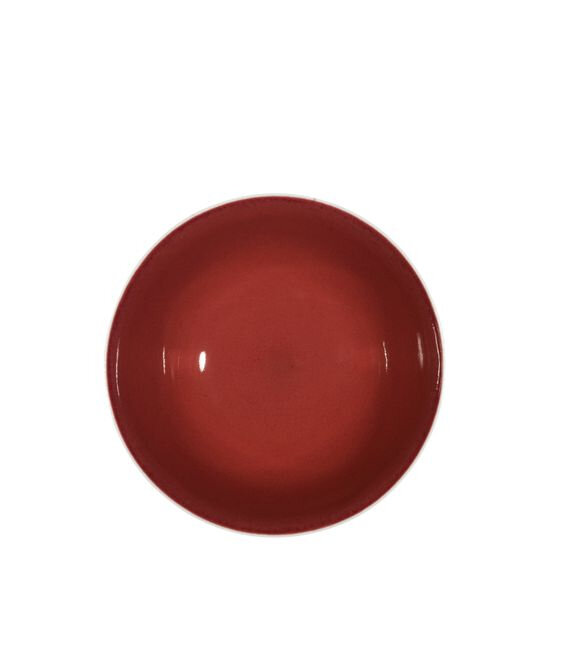An Extremely Rare Copper-Red Stem Bowl, Ming Dynasty, Yongle Period (1403-1424)
Lot 8. An Extremely Rare Copper-Red Stem Bowl, Ming Dynasty, Yongle Period (1403-1424); 15.1 cm., 6 in. Estimate 8,000,000-12,000,000 HKD. Lot Sold 9,620,000 HKD (1,235,978 USD). Photo Sotheby's
finely potted with a shallow flared bowl resting on a tall splayed foot, covered overall in a rich copper-red glaze, slightly speckled near the white rim, the interior of the hollow foot covered with a transparent glaze
Provenance: Collection of Edward T. Chow.
Sotheby’s Hong Kong, 25th November 1980, lot 46.
Exhibited: Chinese Ceramics from the Meiyintang Collection, The British Museum, London, 1994.
Evolution to Perfection. Chinese Ceramics from the Meiyintang CollectionlEvolution vers la perfection. Céramiques de Chine de la Collection Meiyintang, Sporting d’Hiver, Monte Carlo, 1996, cat. no. 108.
Literature: Regina Krahl, Chinese Ceramics from the Meiyintang Collection, London, 1994-2010, vol. 2, no. 653.
Note: Monochrome copper-red vessels of the early Ming period are among the most striking and rares imperial porcelains made in that dynasty. By the Yongle period, the Jingdezhen potters had experimented with this exceedingly difficuitto-fire pigment for about a century and occasionally were able to achieve the desired result cf the rich deep red seen on the present bowl. The rarity of satisfactorily completed examples and the large quantity of sherd finds at the kiln site from the Yongle and Xuande strata suggest that failures were far more common than successes; see Jingdezhen chutu Mingdai yuyao ciqi [Porcelains from the Ming imperial kiins excavated at Jingdezhen], Beijing, 2009, p. 14, fig. 10 (fig. O). OnIy nine intact copper-red stem bowls ofboth periods combined appear to be otherwise preserved, ail except one in museum collections.
Porcelain sherds with copper-red glaze, Yongle period. From the Ming imperial kiln site, Jingdezhen
The National Palace Museum, Taipei, holds three copper-red stem bowls, one cf Yongle mark and period, decorated with dragons inside, published in Minji meihin zuroku. Kbuy, Eirakuy, Sentokuy [lllustrated catalogue of important Ming porcelains. Hongwu, Yongle and Xuande wares], Tokyo, 1977, pI. 30; an unmarked example with traces of a dragon design in gold, and an undecorated example of Xuande mark and period, both included in the Museum’s exhibition Ming dai Xuande guanyao jinghua tezhan tulu/Catalogue of the Special Exhibition of Selected Hsùan-te Imperial Porcelains ofthe Ming Dynasty, Taipei, 1998, cat. nos. 101 and 96.
The Palace Museum, Beijing, holds an unusual stem bowl of Yongle mark and period from the Qing court collection, with red glaze only on the outside and white glaze inside, as well as an unmarked example, fully glazed in red and with traces of a gilt design; see Zhongguo taoci quanji [Complete series on Chinese ceramics], Shanghai, 1999-2000, vol. 13,pis.l2and 17.
Two copper-red glazed stem bowls in the Victoria and Albert Museum, London, are illustrated in John Ayers, Far Eastern Ceramics in the Victoria and Albert Museum, London, 1980, col. pI. 44, both attributed to the early l5th century, but the author suggesting that one, with more widely flared bowl, may belong to the Yongle reign, and the other, with a deeper bowl and shorter stem, to the Xuande period. Ayers also states, p168, that ‘such pieces are hardly found outside the former Chinese palace collections’.
One other red-glazed stem bowl with anhua dragons and a four-character Yongle reign mark inside is in the Idemitsu Museum of Arts, Tokyo, published in Idemitsu Bijutsukan zhin zuroku. Chgoku tji/Chinese Ceramics in the ldemitsu Collection, Tokyo, 1987, pI. 159, and sold in our London rooms l5th April 1980, lot 265; and another also with indistinct anhua dragons inside, included in the Min Chiu Society exhibition of Monochrome Ceramics of the Ming and Ch’ing Dynasties, Hong Kong Museum of Art, Hong Kong, 1977, cat. no. 1, was sold in these rooms, 28th November 1978, lot 117, and is iilustrated in Sotheby’s. Thirty Years in Hong Kong, Hong Kong, 2003, pI. 116.
The Ming imperial kiln site at Jingdezhen has yielded a similar red-glazed stem bowl of Yongle mark and period (fig. I ), an unmarked red-glazed stem bowi recovered together with a number of red-glazed bowis and dishes from the Xuande stratum (fig. 2), and a Xuande-marked example with white inside and red outside (fig. 3); for figs. 2 and 4 see Jingdezhen chutu Mingdai yuyao ciqi, op. cit., pIs. 24 and 46; for fig. 3 see Jingdezhen chutu Ming Xuande guanyao ciqi/Xuande Imperial Porcelain Excavated at Jingdezhen, Chang Foundation, Taipei, 1998, cat. no. 52-1. in the Chang Foundation catalogue Liu Xinyuan compares the subtle changes in vessel shapes from the Yongle to the Xuande reign, and shows, p. 154, the Xuande stem bowi shape to have a fractionally more flared rim and foot, although excavated examples seem to vary in outiine and proportion.
Copper-red stem bowl, Mark and Period of Yongle From the Ming imperial kiln site, Jingdezhen
Copper-red stem bowl Xuande period. From the Ming imperial kiln site, Jingdezhen.
Copper-red and white stembowl, Mark and Period of Xuande. From the Ming imperial kiln site, Jingdezhen.
Sotheby's. The Meiyintang Collection, Part II - An Important Selection of Chinese Porcelains, Hong Kong 5 october 2011

/https%3A%2F%2Fprofilepics.canalblog.com%2Fprofilepics%2F1%2F0%2F100183.jpg)
/https%3A%2F%2Fstorage.canalblog.com%2F03%2F02%2F119589%2F96711876_o.jpg)
/https%3A%2F%2Fstorage.canalblog.com%2F11%2F31%2F119589%2F94773502_o.jpg)
/https%3A%2F%2Fstorage.canalblog.com%2F20%2F83%2F119589%2F94772815_o.jpg)
/https%3A%2F%2Fstorage.canalblog.com%2F26%2F72%2F119589%2F75604929_o.jpg)
/https%3A%2F%2Fstorage.canalblog.com%2F59%2F60%2F119589%2F26458628_o.jpg)









/http%3A%2F%2Fstorage.canalblog.com%2F88%2F26%2F119589%2F129337200_o.jpg)
/http%3A%2F%2Fstorage.canalblog.com%2F51%2F59%2F119589%2F128976423_o.jpg)
/http%3A%2F%2Fstorage.canalblog.com%2F30%2F27%2F119589%2F128677718_o.jpg)